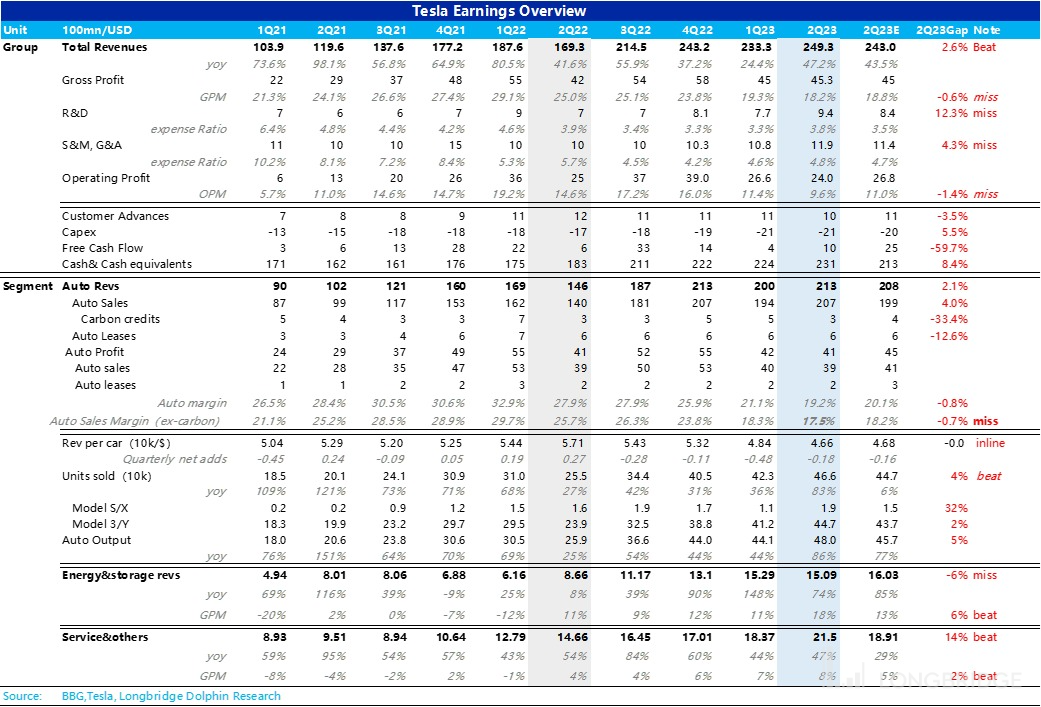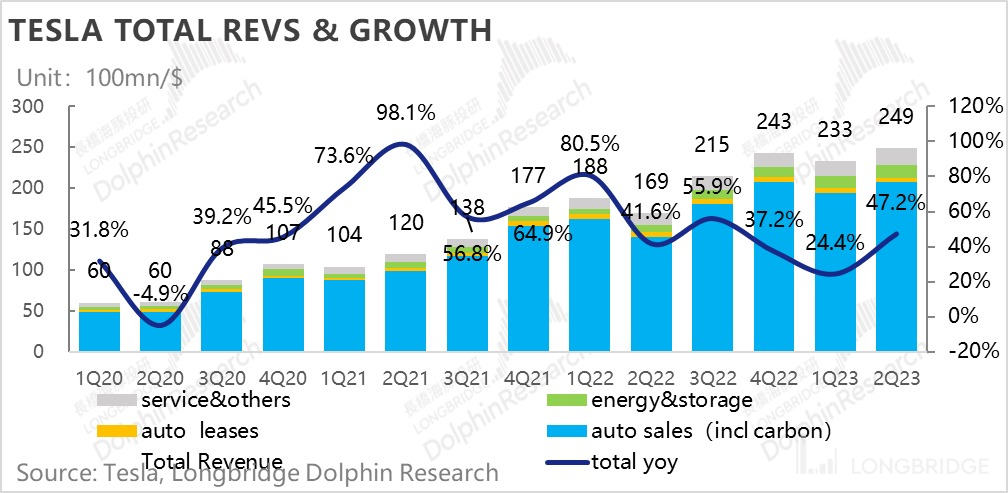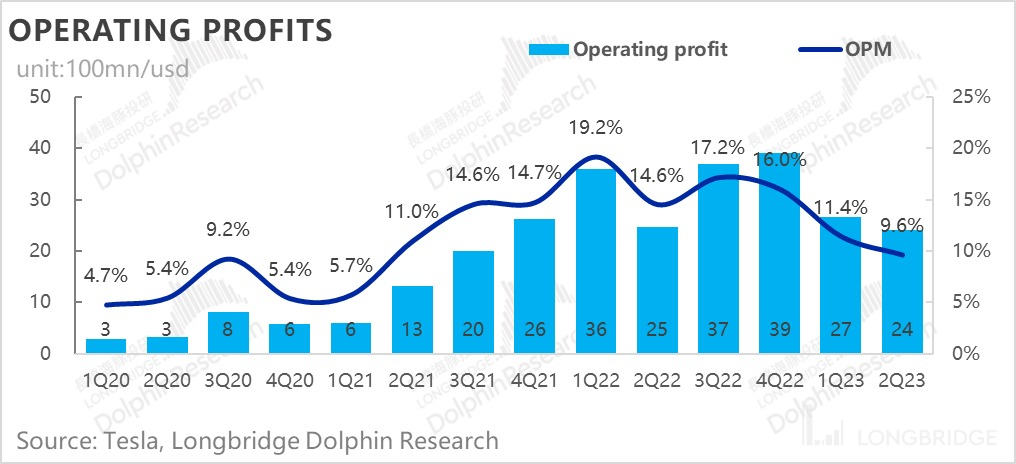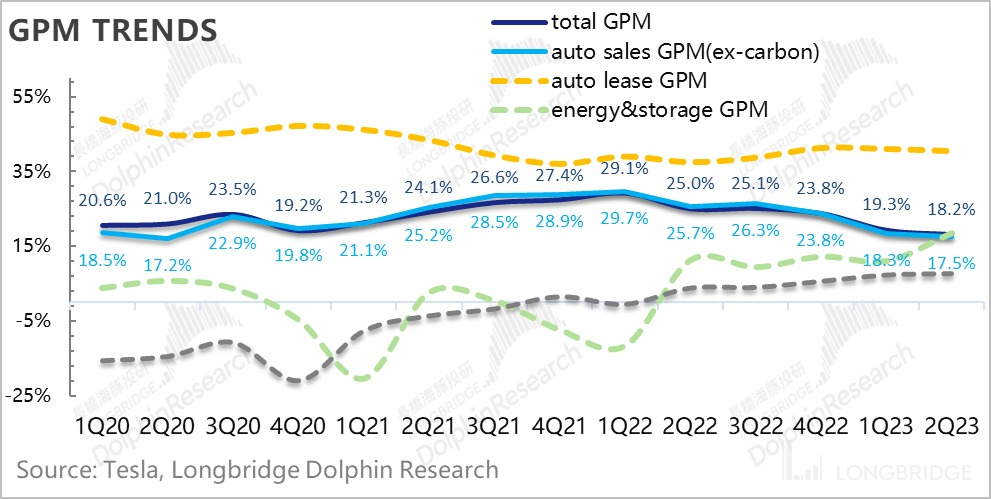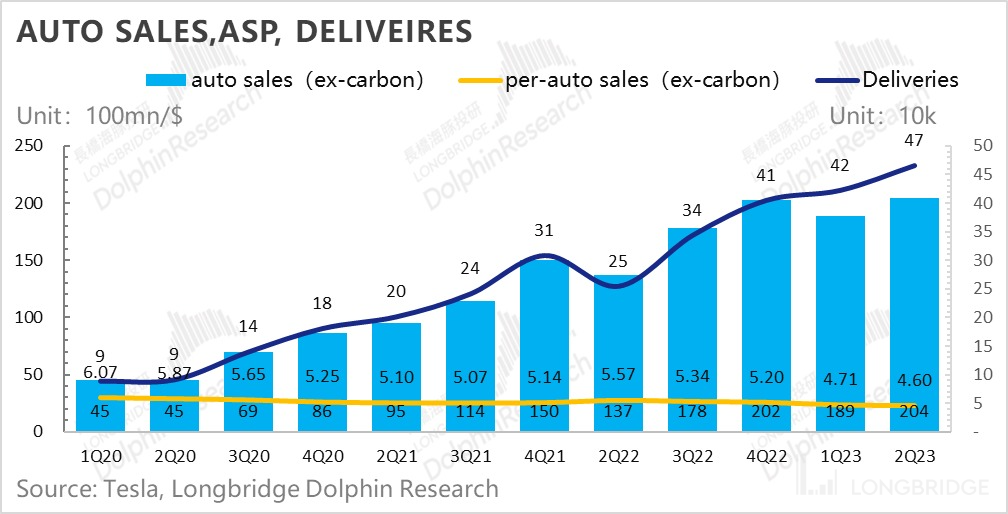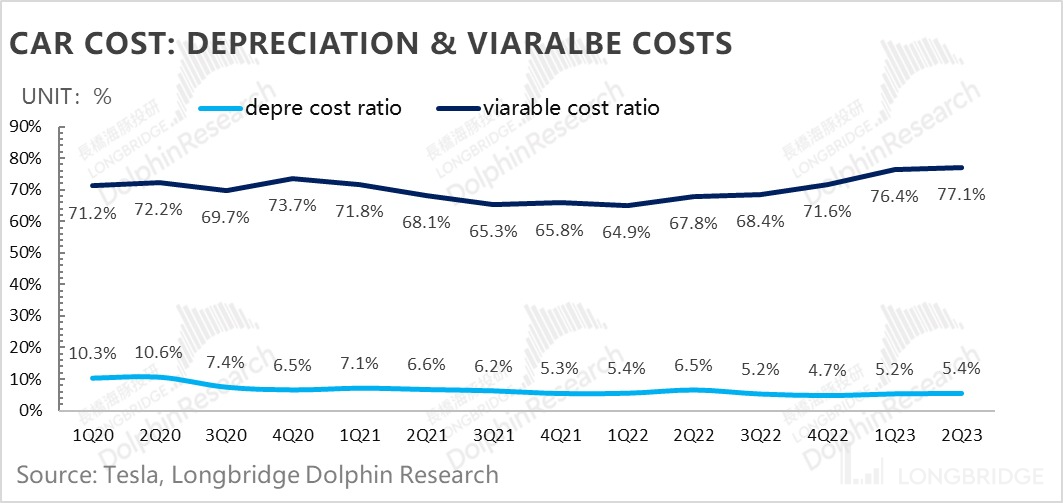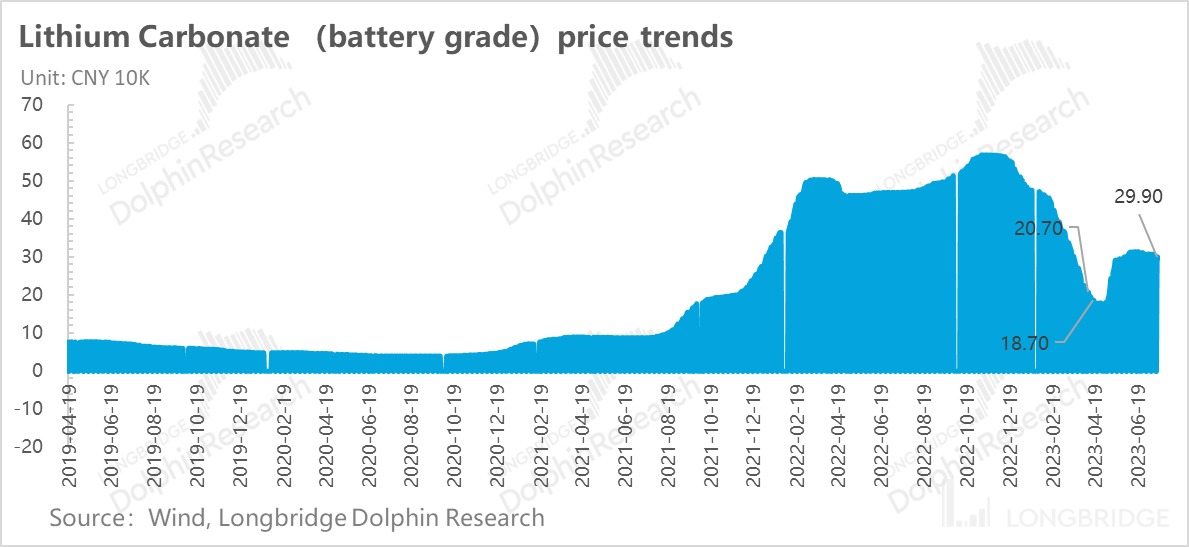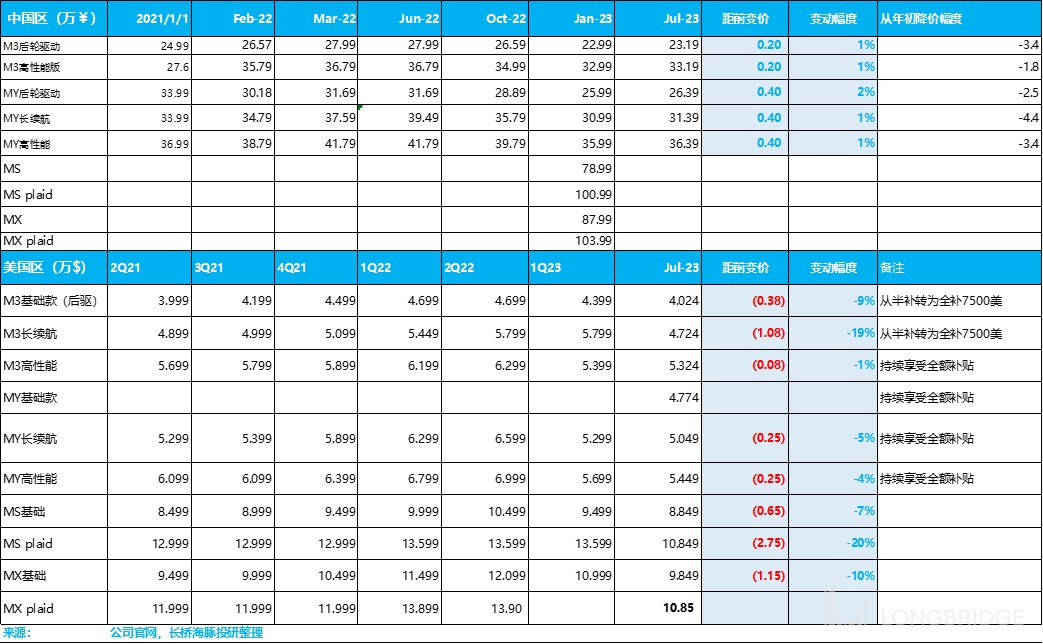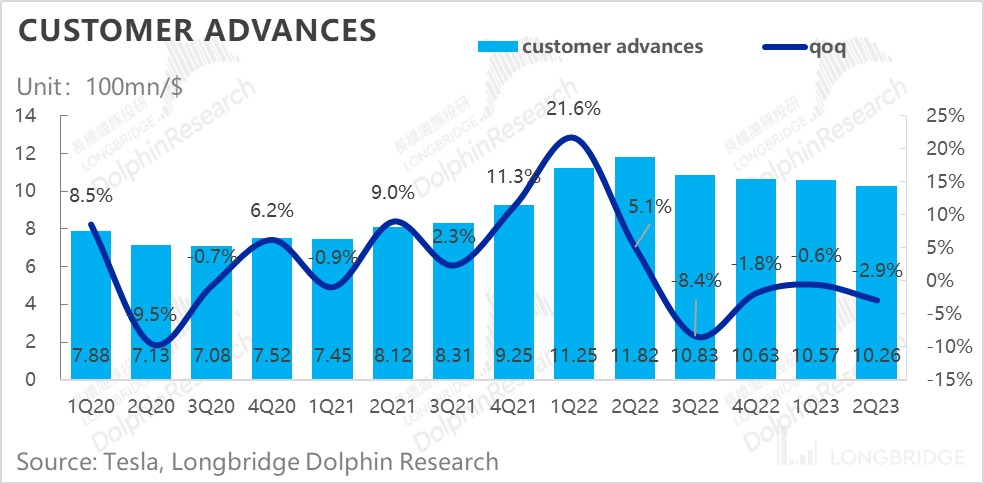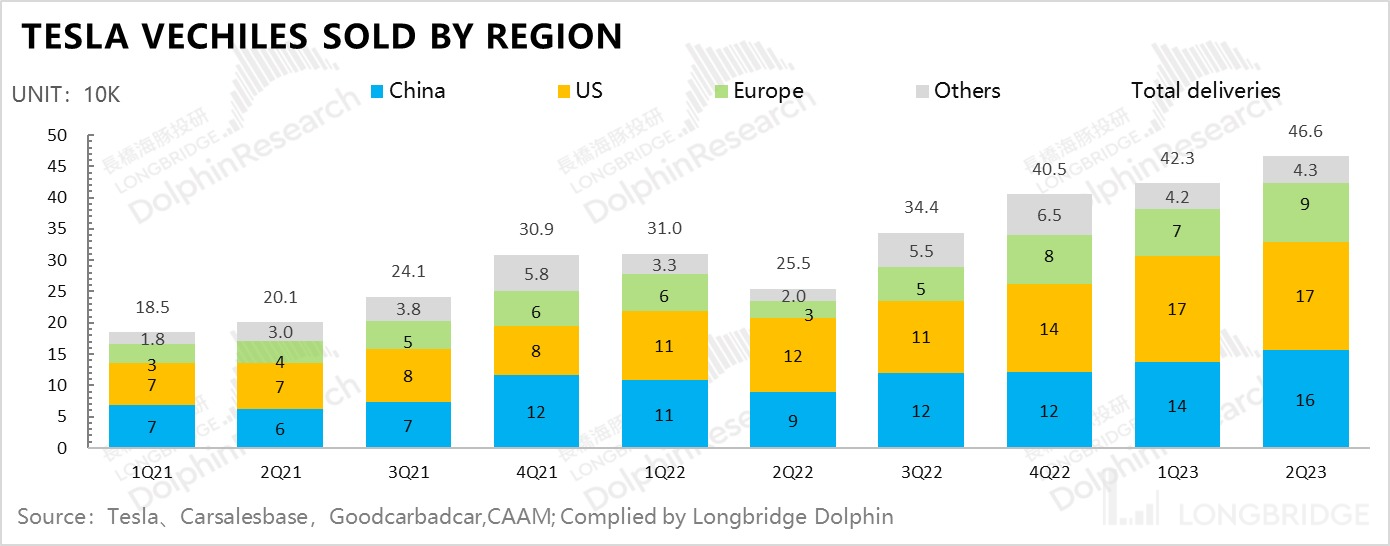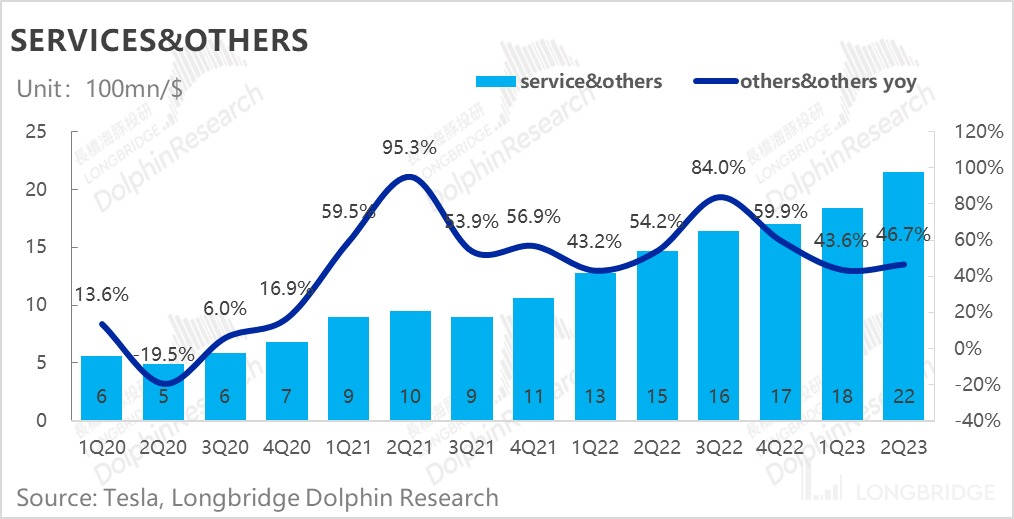
 Likes Received
Likes Received Posts
PostsTrillion-dollar Tesla? Only true fans have the courage to embrace it.

Tesla (TSLA.O) released its Q2 2023 earnings report after the U.S. stock market closed on July 20, Beijing time. Despite the stock price surge of 70%, Tesla's gross margin performance was unsatisfactory.
Here are the key points:
1. Gross margin continues to decline! In Q2, the gross margin of automotive sales (excluding regulatory credits) further slipped to 17.5%, below the market expectation of over 18%. Moreover, there is limited room for sacrificing gross margin at this level.
2. Price reduction under control: With sales volume of 466,000 vehicles in Q2, the sales revenue of $20.7 billion exceeded the market expectation of $19.9 billion. This was mainly due to a modest decrease in average unit price by only 2.5% compared to the previous quarter, resulting in a $1,200 reduction per vehicle.
3. Insufficient cost reduction in key technologies: Among all cost reduction measures, material costs and IRA subsidies have been reduced. However, there is limited room for further decline in lithium carbonate prices, which is a key factor affecting gross margin in Q2. For example, the progress of the 4680 battery technology has been slow, which dilutes the depreciation effect per vehicle and fails to achieve significant cost reduction in terms of battery technology. As a result, out of the $1,200 vehicle price reduction, only $600 can be offset by variable costs, leading to a $600 QoQ decline in vehicle gross margin.
4. Temporary increase in operating expenses: Due to increased R&D investment in the AI era and the upcoming launch of Cybertruck, operating costs in this quarter exceeded market expectations. Although the increase is reasonable, it has contributed to the lower-than-expected operating profit.
5. Operating profit of $2.4 billion, significantly lower than the market expectation of $2.7 billion. The key factor dragging down the performance is the lower-than-expected gross margin in the automotive business. The gross margin and revenue of the energy storage and services business are satisfactory, but their scale is relatively small compared to the automotive business.

Dolphin's overall view:
Since the last quarterly report, Tesla's stock price has risen from $170 to $290, and its market value has exceeded $900 billion, approaching the trillion-dollar mark.
What has happened during this period? Dolphin believes that the most significant change is the shift in market valuation approach, with the increasing use of the "sum-of-the-parts valuation method" for Tesla. The belief in Tesla's potential has become stronger.
These macro catalysts include, but are not limited to:
1) Vehicle sales as the foundation: The macro environment and subsidies are favorable. In the U.S. automotive market, sales have increased despite the high interest rate environment. In the field of electric vehicles, Tesla's Model 3 and Model Y are eligible for the full $7,500 subsidy, offsetting the gross margin erosion caused by price reductions. As a result, Tesla's market share in the U.S. has increased.
2) Valuation of Charging Pile Business Separately? Tesla's charging pile standard has become the standard in the United States, and major American manufacturers have joined Tesla's charging pile network. Another long-term strategic layout has entered the monetization phase, and some people in the market have started to value the charging pile business separately.
3) The Second Curve of Energy Storage Business? In recent quarters, the energy storage business has continued to explode, and Tesla has also started to increase its capacity planning and promotion of energy storage. Although the barriers to entry in the energy storage industry are not as high as in the automotive industry, its growth potential is unlimited. Some people have started to value the energy business separately.
4) FSD's Truly Imaginative Valuation Elasticity? Compared to charging piles and energy storage, FSD has a super high gross profit margin. Although it cannot be proven in the short term, it cannot be disproven either. When the current valuation has already reached $900 billion, some market sellers have started to imagine that FSD can recreate the valuation of the automotive industry, just like Apple did with its services business.
Dolphin understands that Apple also went through a similar transformation when it started talking about its services business. But in terms of fundamentals, Tesla's current situation in the second quarter is that in order to achieve sales volume targets, the gross profit margin target is likely to be sacrificed.
And the current valuation of $300 per share is equivalent to Tesla switching to a STOP valuation method supported by a variety of businesses. However, the penetration rate of FSD business is still very low and basically remains in the imagination stage. The charging pile business has just begun as well. Dolphin feels a lack of imagination and does not dare to casually estimate the valuation of a business worth hundreds of billions of dollars.
In Dolphin's overall estimation, whether it is based on the DCF valuation of the automotive business or the valuation estimation of its divisions, after Tesla's stock price exceeds $300, it has incorporated too much long-term imaginative valuation, which is still relatively distant from realization.
Overall, Dolphin believes that Tesla's position at $300 per share still depends on whether the Cybertruck can achieve explosive sales as scheduled in 2024 and whether the cost-effective butcher-style affordable product priced at $20 million in cost can be released as scheduled in 2024. Before these two things are successfully implemented, the current valuation is too high and the cost-effectiveness of chasing high is low.
The following is a detailed analysis of the financial report:
I. Overall: The United States Market Takes the Initiative and Strikes Four Ways
1.1 Flexible Price War, Revenue Held Steady
In the second quarter of 2023, Tesla's revenue was $24.9 billion, a year-on-year increase of 47%, slightly exceeding the sell-side consensus expectation of $24.3 billion on Bloomberg.
Since the car sales volume has long been known, the slight revenue outperformance is mainly due to the relatively moderate decline in the average selling price of cars after Tesla engaged in a fierce price war in the U.S. market. In addition, Tesla's Supercharger stations have become the industry standard and are being used by more and more major manufacturers such as Ford, resulting in strong performance in the automotive service business.
 1.2 Selling cars comes first, making money comes second:
1.2 Selling cars comes first, making money comes second:
But the most important information that outweighs revenue in every performance is the automotive gross margin performance. Especially for Tesla, the gross margin has increased from 170 in the previous financial report to 290, which is a very demanding performance for a valuation of over $900 billion.
However, Tesla's profit performance is clearly disappointing in this regard: it achieved an operating profit of $2.4 billion in the second quarter of this year, a decrease of 3% compared to a 47% increase in revenue year-on-year, which is significantly lower than the market's expected $2.7 billion. The operating profit margin is only 9.6%.

Apart from the additional sales and R&D expenses brought by the promotion of Cybertruck and the advancement of AI projects, the key issue is still the rapid decline in the gross margin of the main car sales business at the headquarters. Even if other small businesses such as energy storage/photovoltaics and services improve rapidly, they cannot make up for the profit loss caused by the decline in the gross margin of the main business.
1.3 The decline in unit price has slowed down, but the gross profit per vehicle still cannot hold up. As the most important observation indicator for each quarter, the overall gross margin in the second quarter of this year was only 18.2%, still lower than the market's consensus expectation of 18.8%.
The most critical factor is the decline in the gross margin of accumulated car sales, which has further dropped from 18.3% in the previous quarter to 17.5%. The general expectation is above 18%.

Next, let's focus on the impact on the automotive gross margin from an individual vehicle economic perspective.
II. Tesla: Has the strategy of reducing gross margin reached its limit?
2.1 The gross margin of car sales has decreased again!
- In the second quarter, the revenue per vehicle sold (excluding credits and leasing) was $46,000, a decrease of nearly $1,200 compared to the previous quarter, with an actual decrease of 2.5%. This is slightly smaller than the 3-4% decrease estimated by Dolphin, but the gross margin per vehicle has not improved.

By combining the company's depreciation and amortization expenses, Dolphin can clearly see the following economic account for each vehicle:
1) High sales volume does not lead to improvement in depreciation and amortization per vehicle: The depreciation and amortization cost per vehicle sold this quarter is $2,475, which is unchanged compared to the previous quarter. The reason is still the end of the cost amortization effect after the Shanghai factory reached full production, and the slow ramp-up of the 4680 battery factory, which means that although the car sales volume reached a historical high of 466,000 vehicles, the dilution effect on factory costs is almost nonexistent.2) Variable cost per vehicle only reduced by $600: In this quarter, after the price of lithium carbonate went on a roller coaster ride and dropped below 200,000, the price per ton once again reached 300,000. However, from an average price perspective, there was still a certain decline compared to the first quarter. At the same time, all Tesla Model 3 vehicles began receiving the full $7,500 subsidy from the US federal government.
The market originally expected these factors to offset a significant portion of the price reduction impact, allowing Tesla's automotive sales gross margin to remain relatively stable. However, the reality was different.
3) Automotive gross margin takes another step down: The price per vehicle decreased by 1,200 yuan, and there was no improvement in depreciation costs per vehicle. However, the variable cost per vehicle only decreased by 600 yuan, resulting in a significant decline in gross profit per vehicle from the previous quarter to 8,600 US dollars, and further declining to 8,100 US dollars this quarter. The automotive sales gross margin is now only 17.5%.
- Reflected in the cost rate: The improvement in per vehicle costs is too slow, and the new factory is ramping up slowly. In the second quarter, both the per vehicle amortization expense rate and the variable cost rate increased.


Based on the above analysis, it is clear that:
The main reason for the decline in gross margin in the previous quarter was excessive price reductions, but the gross margin in the second quarter continued to be lower than expected. In the opinion of Dolphin, the key issue is insufficient cost reduction:
1) The price per vehicle in the second quarter only decreased by 2.5%, far below the 9%+ decrease in the first quarter.
In the two largest sales markets, China and the United States, Tesla made the following price adjustments: In the Chinese market, after a significant price reduction for the Model Y in January, prices increased by 2,000 yuan in February and May, and the Model 3 increased by 2,000 yuan in May. Overall, prices in China increased by more than 1%.
In the US market, Tesla entered a price war state: After a significant price reduction in the first quarter, on April 7th, the Model 3 and Model Y were reduced by $1,000 and $2,000 respectively, and the Model S and Model X were reduced by $5,000. The overall price reduction ranged from 2% to 6%.
At the same time, Tesla officially launched a lower-priced base model of the Model Y in the United States, equipped with an all-wheel-drive (AWD) powertrain system, with a starting price of $49,990.

In addition, it is worth mentioning that with the $7,500 federal subsidy and a $2,000 subsidy from some states for the 3 and Y models, Tesla's lowest selling price in the United States is now starting at $30,000, which is not much different from the starting price in China.2) The key issue lies in insufficient cost reduction through technology:
The cost reduction in new energy vehicle factories usually comes from three aspects: 1) dilution of sales volume release; 2) technology cost reduction; 3) natural cost reduction of battery raw materials; 4) government subsidies.
From the situation in the second quarter, there is dilution of sales volume release; there are also government subsidies; there is also natural cost reduction of battery raw materials, but the quantity is insufficient, especially in the short term, lithium carbonate is hovering around 300,000.
Therefore, the most critical issue is the problem of technology cost reduction: the 4680 battery, which was expected to achieve cost reduction, has not been able to achieve satisfactory mass production, which on one hand hampers the scale effect of depreciation, and on the other hand, it also leads to unsatisfactory cost reduction in battery technology.
2.2 The crucial issue: When will the automobile gross profit margin stabilize?
After two consecutive quarters of significant decline, Tesla's automobile gross profit margin has dropped to 17.5%. In the opinion of Dolphin, this has already reached the warning line position, and may even be lower than that of domestic automobile peers such as BYD. The practice of sacrificing excessive gross profit margin to boost sales has almost reached its limit.
1) However, in the short term, Tesla still has the impulse to reduce prices. In the absence of new car launches, it will be difficult for Tesla's average selling price to increase in the third quarter.
a) Currently, the delivery time for Model 3 is basically 1-4 weeks for inventory cars, and the delivery time for Model Y is also 2-6 weeks, indicating that the production capacity is clearly sufficient.
b) At the end of the second quarter, customer deposits decreased slightly compared to the first quarter, with only $1.026 billion, a 3% decrease compared to the previous quarter, implying that the order backlog is still decreasing.
c) In the China region, Tesla has frequently taken actions to reduce prices since July: on July 9th, Tesla introduced incentives ranging from 3,500 to 7,000 yuan for customers who refer new customers to purchase Model 3/Y, S/X; on July 1st, Tesla also announced discounts of 35,000 to 45,000 yuan for the purchase of Tesla Model S/X.
2) Key variable: Cost-reduced version of Model 3?
If there continues to be a slight downward trend in prices in the third quarter, maintaining the gross profit margin must find space in cost reduction. However, currently, lithium carbonate has stabilized, and it is also difficult to find space for cost reduction in raw materials. Of course, there is still some room for offsetting through the purchase subsidies in the United States. The remaining key lies in technology cost reduction.
One variable may be the new version of Model 3: according to grassroots research, this redesign focuses on achieving extreme cost reduction without reducing product performance, with a target of reducing the bill of materials (BOM) by less than 15,000 yuan, and an overall cost reduction target of 20,000 to 30,000 yuan.And in terms of the pace of new model releases, according to media reports, the new Model 3 is expected to be released in July 2023, with production starting in September and mass deliveries beginning in 2024.
However, the cost reduction effect of the new Model 3 will only be reflected in 2024. It seems that it will not be easy to repair the automotive gross margin in the second half of this year until the 4680 battery supply (which has increased by 80% compared to the previous period, but is still insufficient compared to Tesla's current sales) comes in.
2.3. The decline in unit price is not severe, and automotive revenue is still good: In the second quarter, the overall sales of automobiles and their associated credits totaled $21.3 billion, a year-on-year increase of 46%, higher than the market's expected $19.9 billion, mainly because the unit price performance was not as bad as expected. Among them, the revenue from automobile leasing business was $570 million, which remained relatively unchanged compared to the previous quarter.
The regulatory credits accounted for a small amount this quarter, less than $300 million, contributing 1.3% of total revenue and nearly 10% of pre-tax profit. After the automotive business gradually becomes profitable, the impact of regulatory credits on profits is gradually decreasing.

III. Selling cars is the top priority
As Dolphin mentioned last quarter: "This production-driven sales strategy basically means that the sales target is highly likely to be achieved. In 2023, the sales volume should not be a place where the market has too much disagreement. The question is how much unit gross profit needs to be sacrificed to achieve this goal."
The actual results in the second quarter were that the sales target was achieved, but the gross margin was lower than expected, which is consistent with Dolphin's judgment. The dynamic comparison between sales volume and gross margin once again illustrates:
Even though the market has shifted from supply-oriented to demand-oriented, Tesla still adheres to the strategy of capacity-oriented production, selling as much as it produces, sacrificing gross profit for market share, with the aim of aggressively promoting the replacement of fuel vehicles with new energy vehicles.
The company had set a minimum target of 1.8 million and an upper limit of 2 million for the fourth quarter. The first quarter performance slightly fell short of the target at 1.8 million vehicles. Dolphin noticed that even after the second quarter sales exceeded market expectations, most of the market still maintains an annual sales volume of 1.8 million.

In Dolphin's view, under the current strategy of selling as long as it is produced, even if it means lowering prices, there is a high probability of exceeding 1.8 million in sales this year.
In terms of policy benefits, the tax exemption policy for new energy vehicles in China has been confirmed again; although interest rates in the United States are high, the attractive national and local subsidies offset the impact of the higher interest rates, which is conducive to further increasing the penetration rate of new energy vehicles.
Especially in the U.S. market, the penetration rate of new energy vehicles is still in the single digits. With government subsidies and Tesla's aggressive price reductions, there is an opportunity to significantly increase the penetration rate of the U.S. market and gradually catch up with the Chinese and European markets.Three, Energy and Services: Unlocking the SOTP Valuation Method?
3.1 Abundant Energy: Tesla's energy storage and photovoltaic business includes selling photovoltaic systems and energy storage systems to residential customers (to C), small and medium-sized commercial customers (to B), and large commercial and utility-level customers.
In the second quarter of this year, revenue reached $1.5 billion, a year-on-year increase of 74%. However, as a business that grows quarter by quarter, this quarter's MoM decline is rare and lower than the market's expected $1.6 billion.
The driving force behind the growth mainly comes from the energy storage business. Due to the increased capacity of the California Megapack factory, the installation volume in the second quarter has reached 3.7GWh, a YoY growth rate of 222%.
In addition to capacity expansion, on April 9th, Tesla's energy storage super factory landed in Shanghai, which is used to produce Megapack, a super large-scale commercial energy storage battery, and supply it to the global market. The initial planned annual output is 10,000 units, with an energy storage capacity of nearly 40GWh. It is planned to start construction in 23Q3 and officially put into operation in 24Q2.
The installation of photovoltaic roofs has encountered obvious bottlenecks, with both YoY and MoM declines, mainly due to the high interest rate environment and the decline in gas prices, which has dampened the enthusiasm for photovoltaic installation.
At the same time, the gross profit margin continues to rise and has reached 18% in the second quarter, surpassing the gross profit margin of the automotive sales business. The gross profit margin is getting closer to the normal industry gross profit margin of the battery business.
Overall, with the increase in energy storage business and the improvement of gross profit margin, Tesla's energy business has gradually become a business with long-term prospects and short-term implementation. In the eyes of capital, this business has already begun to have independent valuation logic, and judging from the recent stock price performance, it has also gained considerable valuation.
3.2 Charging Piles in the Harvesting Period? In the second quarter, Tesla's service business achieved revenue of $2.15 billion, with a YoY accelerated growth rate of 47%, and the gross profit margin further increased to 8%.
And in this second quarter, in the service business sector, it has become the quarter of charging piles. At the end of June 2023, the International Society of Automotive Engineers announced that it will standardize the Tesla North American Charging Standard (NACS) interface design in the next six months, which means that Tesla's charging technology will become the general standard in North America.
As of June 30th, six automakers, including Volkswagen, Ford, General Motors, Rivian, Volvo, and Polestar, have announced their adoption of this charging standard. It seems that Tesla's business of "doing the right thing in the long run" has entered the monetization period once again.
Dolphin's historical articles, please refer to:
Interpretation of the financial report on April 20, 2023: "Tesla: It's hard to have a big year and a small year, 'long-lasting companionship'" (https://longportapp.com/en/topics/5281637?app_id=longbridge)
Financial report conference call on April 20, 2023: "Tesla: Confidently selling cars at zero profit, reaping with autonomous driving" (https://longportapp.com/en/topics/5306981?app_id=longbridge&channel=t5306981&invite-code=276530)
Interpretation of the financial report on January 26, 2023: "Tesla's story reshaped, the moment of testing faith has come!" (https://longportapp.com/en/topics/3886866?app_id=longbridge&channel=t3886866&invite-code=276530)
Conference call on January 26, 2023: "Tesla minutes: 'No competitor even with a telescope for autonomous driving, the second Tesla may be in China'" (https://longportapp.com/en/topics/3887318?app_id=longbridge&channel=t3887318&invite-code=276530)
Interpretation of the financial report on October 20, 2022: "Fatal question: When demand is insufficient, how can single-car profitability be maintained?" (https://longportapp.com/en/topics/3554145?channel=t3554145&invite-code=276530)
Conference call on October 20, 2022: "Minutes: 'Internal combustion cars are doomed, no production cuts at any time'" (https://longportapp.com/en/topics/3554209?channel=t3554209&invite-code=276530)
Interpretation of the financial report on July 21, 2022: "Without the Shanghai factory's blood transfusion, what can Tesla rely on?" (https://longbridgeapp.com/en/topics/3161925?invite-code=032064)
Conference call on July 21, 2022: "Musk: Even with repeated price increases, I'm embarrassed" (https://longbridgeapp.com/en/topics/3162785?channel=t3162785&invite-code=276530) 2022 June 6th viewpoint update "Did the US stock market suffer a major quake that wrongly killed Apple, Tesla, and NVIDIA?".
April 21st, 2022 "New energy roaring, Tesla bull run continues".
April 21st, 2022 "New factory production capacity increases, Tesla will deliver 1.5 million cars in 2022 (meeting minutes)".
February 28th, 2022 viewpoint update "Scattered hearts, putting safety first when investing in Tesla".
January 27th, 2022 telephone conference call "Tesla: Musk emphasizes the importance and potential value of FSD (telephone conference summary)".
January 27th, 2022 financial report review "Tesla, the indisputable champion, will it take a halftime break?".
December 6th, 2021 viewpoint update "With Musk selling tickets for tax exemption, what will happen to Tesla's stock price?".
October 21st, 2021 telephone conference call "Tesla: selling a million cars a year is within reach, is Musk hands-off?".
October 21st, 2021 financial report review "Tesla: wooden girl cries out for $3000, is the sky the limit?".
July 27th, 2021 telephone conference call "Tesla's 2021 Q2 earnings call summary".
July 27th, 2021 financial report review "Tesla: there is always something stronger, and even stronger!".-2021 年 04 月 27 日电话会 《特斯拉 2021Q1 业绩直播纪要》
-2021 年 04 月 27 日财报点评《 特斯拉没惊喜没惊吓的一季报后,还有什么可期待?》
-2021 年 06 月 03 日深度《 特斯拉(下):错杀还是高估,特斯拉的故事讲到了哪里?》
-2021 年 05 月 21 日深度《 10 年 300 倍,“魔性” 特斯拉还能魔多久?》
Risk Disclosure and Disclaimer for this article: Disclaimer and General Disclosure by Dolphin Analyst
The copyright of this article belongs to the original author/organization.
The views expressed herein are solely those of the author and do not reflect the stance of the platform. The content is intended for investment reference purposes only and shall not be considered as investment advice. Please contact us if you have any questions or suggestions regarding the content services provided by the platform.

